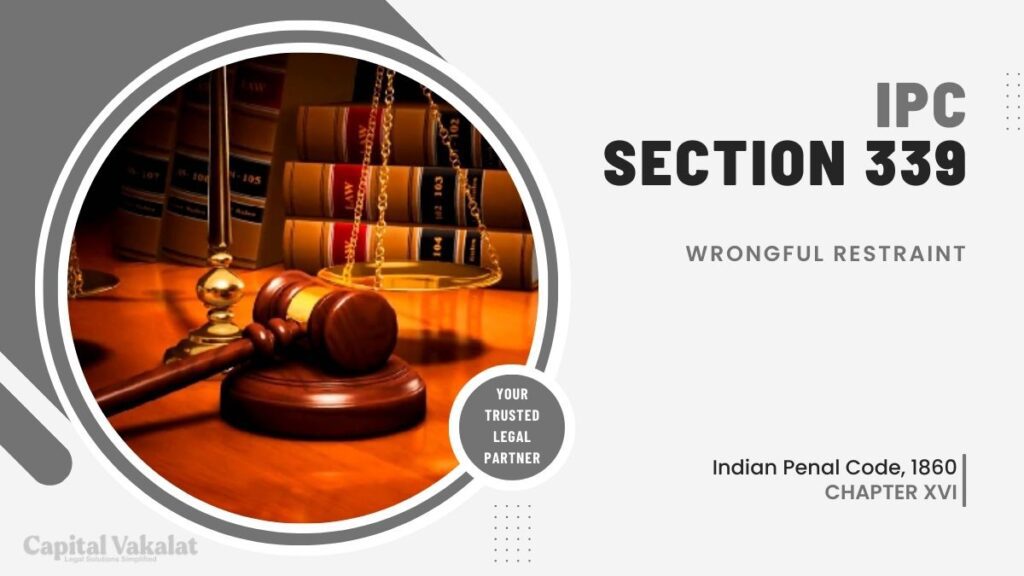In the intricate tapestry of the Indian Penal Code (IPC), Section 339 stands as a sentinel against a particular transgression – Wrongful Restraint.

Understanding the intricacies of this legal provision is crucial in comprehending the boundaries of personal freedom and societal order.
Historical Context of Section 339 IPC
Section 339 has its roots deep in the historical evolution of Indian law. Originating from the initial versions of the IPC, it has undergone amendments to align with the evolving societal norms. Notable legal cases have played a role in shaping the contours of this section, establishing precedents that guide its interpretation today.
Elements of Wrongful Restraint
To comprehend the implications of Wrongful Restraint, one must dissect its elements. It involves intentionally obstructing a person’s liberty, using force or the threat of force. For instance, holding someone against their will or preventing them from moving freely in a public space constitutes wrongful restraint.
Differentiating Wrongful Restraint from Other Offenses
Wrongful Restraint is often misconstrued with other offenses like kidnapping or criminal intimidation. Drawing clear distinctions is imperative for fair legal proceedings. Wrongful Restraint focuses on restricting physical movement without involving the intent to harm or extort.
Punishments and Legal Consequences
The legal consequences for Wrongful Restraint vary based on the severity of the offense. Penalties may include fines or imprisonment. However, understanding the nuances of the law and potential defenses is crucial for those accused of such offenses.
Landmark Legal Cases
Landmark legal cases provide valuable insights into the practical application of Section 339 IPC. Decisions by the judiciary serve as benchmarks, influencing how subsequent cases are approached. Examining these cases helps in comprehending the evolving nature of legal interpretations.
Challenges in Prosecuting Wrongful Restraint Cases
Legal proceedings are not without challenges. Wrongful Restraint cases face hurdles, from gathering evidence to establishing intent. Addressing these challenges requires a nuanced approach, perhaps through legal reforms or improved investigative techniques.
Preventive Measures and Awareness
Preventing Wrongful Restraint involves a combination of personal responsibility and societal awareness. Simple measures, such as avoiding confrontations and understanding one’s legal rights, can significantly reduce the likelihood of encountering such situations.
Public Perception and Social Impact
Public perception plays a crucial role in shaping the impact of legal provisions. Examining how society views Wrongful Restraint cases provides insights into the effectiveness of the law and areas that may need attention.
Conclusion
In conclusion, Section 339 IPC serves as a guardian of individual freedom within the legal framework. Its historical evolution, elements, and consequences underscore its significance in maintaining order. While challenges persist, a comprehensive understanding of Wrongful Restraint is vital for a fair and just legal system.
Frequently Asked Questions
Can self-defense be a valid defense against Wrongful Restraint charges?
In some cases, self-defense can be a valid defense. However, it must be proportionate to the threat faced, and the burden of proof lies with the accused.
How can one avoid Wrongful Restraint situations?
Being aware of surroundings, avoiding confrontations, and understanding one’s legal rights are essential in preventing Wrongful Restraint situations.
What distinguishes Wrongful Restraint from kidnapping?
Wrongful Restraint involves restricting physical movement without the intent to harm or extort, whereas kidnapping typically involves abduction with malicious intent.
Are there any proposed reforms to address challenges in prosecuting Wrongful Restraint cases?
Legal scholars and practitioners often propose reforms to address challenges, such as improving investigative techniques and streamlining legal procedures.